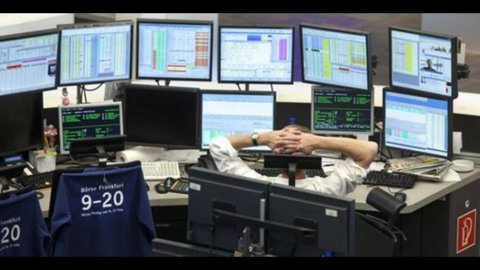Even today it is one bad day for the financial markets, which no longer seem capable of stably resolving the most serious tensions. Why, despite all the measures taken at a national and international level, do sales on stock exchanges around the world come back with this frequency? To try to better understand the reasons at the root of the problem, FIRSTonline publishes the slides edited by Alberto Giovannini, managing director of Unifortune asset management and head of multi-manager funds. Giovannini was deputy general manager of Banca di Roma (for markets, prop trading and investment banking), and, previously, senior advisor and senior strategist of Long-term Capital Management, LP, the investment management company in Greenwich, in Connecticut. Academically, he is was Professor of Economics and Finance at Columbia University in New York.
ALBERTO GIOVANNINI'S SLIDES
FINANCIAL CRISIS = MARKET FAILURE
• One of the main economic functions of the financial system is liquidity transformation: investors with different and uncorrelated liquidity needs can, when aggregated, offer stable resources.
• Stable resources allow for longer-term plans and reduce uncertainty: this is why the transformation of liquidity produces added value, both private and social.
• This is the (traditional) business of banks.
• But it is also the function of the financial markets.
• When, for whatever reason, market participants or bank depositors lose confidence, their behaviors become correlated and the liquidity transformation collapses.
• And since the behavior of each depends on the behavior of the others, there are multiple equilibria, and the collapse of liquidity is a failure of the market.
THE EVOLUTION OF BANKS
• Increasingly less transformation of liquidity in the balance sheet (traditional business).
• “Originators” and “Market Makers”—continue to be the major players in the transformation of liquidity, but especially in the securities market.
• As a result, they are generally highly exposed to the risk of liquidity collapses.
• Furthermore, banks carry out not only customer services but also (and in some cases above all) investment activities on their own account.
• Finally, in their role as "Market Makers" they also become central counterparties.
THE DEBT OF THE BANKS
• Total assets of the European banking system: 325% of the European GDP.
• Leverage of the 15 largest banks: 28,9 times the capital.
• Bank debt on international markets: €4900 trillion, 27% of the total stock in the Eurozone.
• According to Barclays Capital: Europe's 15 largest banks increased their ROE by 58% over the period 1998-2007—90% of the increase caused by increased leverage (Source: Gene Frieda).
THE FRENCH BANKS
• Risk-weighted assets: €2200 trillion.
• Capital: €167 billion (7,6%).
• Total assets: €8100 trillion.
• Capital/assets ratio = 2,06%, leverage = 50.
• €840 billion financed on the institutional market.
THE DIFFICULT ROLE OF CENTRAL BANKS
• Central banks suffer from a chronic information deficit about what is happening in the markets, which became mammoth at the beginning of the 2007/2008 crisis—famous Geithner's speech in December 2006, in which he stated that the US banking system was more than adequate capitalized.
• Their work is disproportionately macroeconomic: this is particularly evident in the case of the ECB.
• Have fallen into the “low interest rate trap”.
• They struggle to play the role of systemic risk managers.
THE REGULATORY SYSTEM
• It was well designed in a financial market where the transformation of liquidity took place only within the banks:
– Capital requirements
– Discount window
– Supervision
• Supervision of the markets inspired almost exclusively by the objective of investor protection, and not by systemic stability.
• “Systemic Risk Managers” not explicitly recognised.
WHAT IT MEANS AND HOW TO ACHIEVE THE RETURN TO NORMALITY OF THE MARKETS
• A well-functioning (normally functioning) financial system requires the solution of the structural problems discussed above:
– A system for preventing and managing liquidity crises, both internally and externally
from banks
– A system that allows central banks to regain their role as managers of the
systemic risk
– A system that minimizes the multiplier effects of counterparty risk
– A system in which the different actors are subject to operational constraints suited to the role that
play (Volcker rule and more)
• The most difficult challenge: how to get to this "normal" system starting from the current situation.
THE DIRECTIONS OF THE REFORM
• Banks: qualitative and quantitative capital and liquidity requirements, separation of customer service activities from (in conflict) equity investment activities (in the US, and similar rules in the UK: Vickers Report).
• Banks: stress tests.
• General tendency to bring each intermediary back into the regulatory fold (particularly hedge funds).
• Use of central counterparties to limit contagion through counterparty risk.
• Effort to collect an acceptable database on the distribution of risk in the financial system (example: trade repositories).
PROJECTED IMPACT
• The use of central counterparties can help minimize an important multiplier of uncertainty in the presence of a financial crisis, and also facilitates the collection of information on the distribution and concentration of risks.
• Limiting excessive risk by banks, through capital requirements and business separation rules also goes in the right direction.
• However, important liquidity transformers and collateral creators remain out: for example, money market funds (“narrow savings banks”) and securitization vehicles (“narrow funding banks”)
• The project to collect and use all data on the financial system for use by systemic risk managers is overdue and incomplete.
THE OPEN QUESTIONS
• Sovereign states are the market actors best suited to offer security, but this function was lost with the Euro crisis, and in other countries previously.
• What could be the geography of sovereign debts in a “normal” Euro area? There are two hypotheses:
– The accompaniment of a common bond to national bonds
– The “tranching” of each state's liabilities
• How will the role of the European Central Bank evolve? In addition to monitoring traditional monetary aggregates, such as M2, the ECB should monitor one monetary aggregate relevant to the financial system—the stock of collateral, which represents the counterpart of financial transactions.
• Fluctuations in the stock of collateral have the same effect on the financial system as fluctuations in the real economy do: excessive contractions suffocate the system while excessive expansions cause the accumulation of systemic risks.





